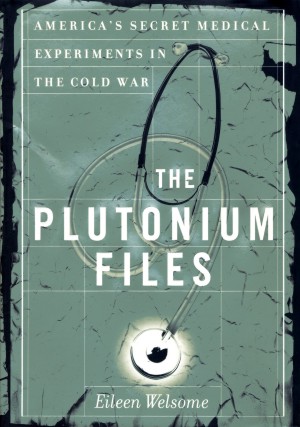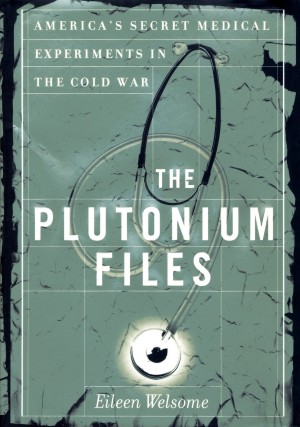
In 1994, following the publication of a series of articles on plutonium injections of American citizens, President Clinton appointed an advisory committee on human radiation experiments to investigate the matter and gave it access to thousands of secret documents. Jonathan D. Moreno, a biomedical ethicist at the University of Virginia, worked for the committee, then went on to examine the broad history of experiments that the United States Government had secretly conducted on human subjects in the interest of national security from World War II through the cold war. One such secret experiment on a unsuspecting African American man, prematurely ended his life.

Ebb Cade Experiment
In 1945, African-American Ebb Cade was secretly injected with plutonium, the substance used to make nuclear bombs. Cade, a 53-year-old truck driver, was taken to a hospital in Oak Ridge, Tennessee, after breaking several of his bones in a car accident. He became an unwitting guinea pig in a deadly government experiment, and did not realize the doctors caring for him were also employed by the US Atomic Energy Commission. The doctors had been ordered to find out what exposure to plutonium did to the human body.
It was on 23 March 1945 Ebb Cade was on his way to work at a construction site for the Manhattan Project when he was involved in a traffic accident at Oak Ridge, Tennessee. He was a cement worker for the J.A. Jones Construction Company. Cade presented at the Oak Ridge Hospital with fractures of right patella, right radius and ulna and left femur. Ebb Cade received the injections at the Oak Ridge Hospital on the Clinton Engineer Works reservation at Oak Ridge, Tennessee. Cade became known as HP-12 (Human Product-12), and was the first person to be injected with Pu-239. In order to test the migration of plutonium through his body, subsequently fifteen of Cade’s teeth were extracted, and bone samples taken.
Injured and helpless in a hospital bed, Ebb Cade was injected with 0.29 microcuries of plutonium-239, more than 40 times the amount a person might expect to be exposed to in an entire lifetime.

A researcher who worked at the hospital in the 1940s described it as “a whopping dose” years later. In their efforts to see the effects of plutonium, the researchers pulled out 15 of Cade’s teeth to measure plutonium levels in his system. They also collected chips of his bones for study. Held in the hospital for more than six months, Cade rightly suspected that it did not take this long for his broken bones to heal and that he was, in fact, being kept in hospital to be used as a guinea pig.
So, his broken limbs healed, Cade fled the hospital when doctors and nurses were not looking. But he could not escape what the secret nuclear experiments had done to him. Described by doctors when he arrived at the hospital in Oak Ridge as a “well developed and well nourished colored male in good health”, Cade died a few years later of heart failure, aged 61.
Operation Drop Kick
Undaunted by what it had done to Cade in 1945, the US government targeted other African-Americans for experimentation in the 1950s. Early in that decade, the CIA and the US military released close to half a million mosquitoes infected with yellow fever and dengue fever into several black neighbourhoods in Florida.
Between April and November 1956, the U.S. Army Chemical Corps conducted Operation Drop Kick to test the practicality of employing mosquitoes to carry an entomological warfare agent in different ways. The Corps released uninfected female mosquitoes into a cooperative residential area of Savannah, Georgia, and then estimated how many mosquitoes entered houses and bit people. Within a day the mosquitoes had bitten many people. In 1958, the Corps released 600,000 mosquitoes in Avon Park, Florida.
The experiments in Avon Park, about 170 miles from Miami, were covertly conducted in a low-income African-American neighborhood that contained several newly constructed public housing projects. CIA documents related to its top-secret Project MK/NAOMI clearly indicate that the mosquitoes used in Avon Park were the Aedes aegypti type which carried the dengue fever virus. Besides dengue, some of the mosquitoes were also carrying yellow fever.
The mosquitoes were dropped from planes in special paper bags designed to burst open when they hit the ground, sending the infected insects off to bite as many African-Americans as they could. The military wanted to find out whether the mosquitoes could prove to be an effective weapon of war that could be used to infect, incapacitate, and kill America’s enemies.
Dozens of African-Americans in the mostly black city of Avon Park, in South Florida, became ill and at least eight residents died from the invasion of the mosquitoes. “Nobody knew about what had gone on here for years,” said a long-time resident of Avon Park. “But in looking back, it explained why a bunch of healthy people got sick and died at the time of those experiments.”

A longtime Avon Park resident, Beatrice Peterson, didn’t know about mosquito releases but recalled that screwworm flies were released in the mid to late 1950s. She was only 14-years-old at the time.
“We know they released some flies, but what was the reason and why, I can’t remember why because we were in school back in the 1950s,” Peterson said. “Occasionally we would see them when they fly over and drop the little boxes out. Evidently the boxes were supposed to open up.”

